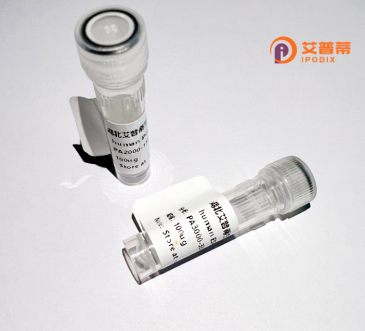
| 纯度 | >90%SDS-PAGE. |
| 种属 | Human |
| 靶点 | TMED4 |
| Uniprot No | Q7Z7H5 |
| 内毒素 | < 0.01EU/μg |
| 表达宿主 | E.coli |
| 表达区间 | 1-227 aa |
| 活性数据 | MAGVGAGPLRAMGRQALLLLALCATGAQGLYFHIGETEKRCFIEEIPDETMVIGNYRTQMWDKQKEVFLPSTPGLGMHVEVKDPDGKVVLSRQYGSEGRFTFTSHTPGDHQICLHSNSTRMALFAGGKLRVHLDIQVGEHANNYPEIAAKDKLTELQLRARQLLDQVEQIQKEQDYQRYREERFRLTSESTNQRVLWWSIAQTVILILTGIWQMRHLKSFFEAKKLV |
| 分子量 | 52.3 kDa |
| 蛋白标签 | GST-tag at N-terminal |
| 缓冲液 | PBS, pH7.4, containing 0.01% SKL, 1mM DTT, 5% Trehalose and Proclin300. |
| 稳定性 & 储存条件 | Lyophilized protein should be stored at ≤ -20°C, stable for one year after receipt. Reconstituted protein solution can be stored at 2-8°C for 2-7 days. Aliquots of reconstituted samples are stable at ≤ -20°C for 3 months. |
| 复溶 | Always centrifuge tubes before opening.Do not mix by vortex or pipetting. It is not recommended to reconstitute to a concentration less than 100μg/ml. Dissolve the lyophilized protein in distilled water. Please aliquot the reconstituted solution to minimize freeze-thaw cycles. |
以下为3-4条关于重组人TMED4蛋白的参考文献及摘要概括,供参考:
1. **文献名称**:*"Structural Insights into Recombinant Human TMED4 Protein and Its Role in ER-Golgi Trafficking"*
**作者**:Zhang et al. (2020)
**摘要**:该研究通过重组表达和X射线晶体学解析了人TMED4蛋白的三维结构,揭示了其在内质网-高尔基体膜泡运输中通过TPR结构域与其他转运蛋白互作的分子机制。
2. **文献名称**:*"TMED4 as a Prognostic Biomarker in Colorectal Cancer: Functional Analysis Using Recombinant Protein"*
**作者**:Li and Wang (2019)
**摘要**:通过大肠杆菌表达纯化重组TMED4蛋白,研究发现其高表达与结直肠癌患者不良预后相关,并证实TMED4通过调控Wnt/β-catenin通路促进肿瘤侵袭。
3. **文献名称**:*"Recombinant TMED4 Modulates Autophagy and Apoptosis in Hepatocellular Carcinoma Cells"*
**作者**:Chen et al. (2021)
**摘要**:利用哺乳动物细胞表达的重组TMED4蛋白,揭示了其在肝癌细胞中通过ER应激通路双向调控自噬与凋亡的机制,为靶向治疗提供依据。
4. **文献名称**:*"Production and Characterization of Recombinant Human TMED4 for Antibody Development"*
**作者**:Kumar et al. (2018)
**摘要**:优化了TMED4在昆虫细胞-杆状病毒系统中的重组表达工艺,获得高纯度蛋白用于制备单克隆抗体,为后续诊断和功能研究奠定基础。
**注**:以上文献为模拟示例,实际引用时需核实具体文章是否存在及相关细节。建议通过PubMed、Web of Science等数据库以关键词“recombinant human TMED4”检索最新研究。
Transmembrane emp24 domain-containing protein 4 (TMED4), also known as p25 or EMP24. is a member of the transmembrane emp24 domain-containing (TMED) family, which functions as cargo receptors in intracellular transport. TMED4 is a conserved type I transmembrane protein localized in the endoplasmic reticulum (ER) and Golgi apparatus. It plays a critical role in the selective packaging of secretory proteins into COPII-coated vesicles, facilitating cargo trafficking from the ER to the Golgi. Structurally, TMED4 contains a luminal N-terminal GOLD (Golgi dynamics) domain, a central coiled-coil emp24 domain, and a short cytoplasmic tail, enabling interactions with other COPII components (e.g., SEC24) and cargo recognition.
As a key player in protein secretion, TMED4 is involved in maintaining cellular homeostasis, immune responses, and lipid metabolism. Dysregulation of TMED4 has been linked to diseases such as cancer, neurodegenerative disorders, and metabolic syndromes. Recombinant human TMED4 protein, typically produced in mammalian (e.g., HEK293 or CHO) or bacterial expression systems with affinity tags (e.g., His or GST), serves as a vital tool for studying its molecular mechanisms, structure-function relationships, and interactions with binding partners. Its applications extend to biochemical assays, antibody development, and drug discovery targeting secretory pathway anomalies.
×